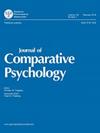What makes the ephemeral reward task so difficult?
IF 1.1
4区 心理学
Q4 BEHAVIORAL SCIENCES
引用次数: 0
Abstract
The ephemeral reward task involves providing subjects with a choice between two distinctive stimuli, A and B, each containing an identical reward. If A is chosen, the reward associated with A is obtained and the trial is over. If B is chosen, the reward associated with B is obtained but A remains, and the reward associated with A can be obtained as well. Thus, the reward-maximizing solution is to choose B first. Although cleaner fish (wrasse) and parrots easily acquire the optimal response by choosing B, paradoxically, several nonhuman primate species, as well as rats and pigeons, do not. It appears that some species do not associate their choice and reward with the second reward. Surprisingly, research in an operant context with pigeons and rats suggests that inserting a delay between the choice and reward facilitates optimal choice. It is suggested that impulsivity may be, in part, responsible for the difficulty of the task. In an attempt to better understand this task, we trained human subjects on an operant version of this task, with and without a brief delay between choice and reward and found that many subjects failed to learn to choose optimally, independent of the delay. Furthermore, performance on this task was not correlated with a task thought to measure impulsivity, the Balloon Analog Risk Task or with the Abbreviated Impulsivity Survey. We concluded that, for humans, the task is confusing because there is no incorrect response, only good and better, and better is not easily discriminated. (PsycInfo Database Record (c) 2024 APA, all rights reserved).是什么让短暂的奖励任务变得如此困难?
短暂奖赏任务是让受试者在两个不同的刺激物 A 和 B 之间做出选择,每个刺激物都含有相同的奖赏。如果选择 A,则获得与 A 相关的奖励,试验结束。如果选择了 B,则获得了与 B 相关的奖励,但 A 仍然存在,同时也可以获得与 A 相关的奖励。因此,奖励最大化的方案是先选择 B。虽然清洁鱼(尖嘴鱼)和鹦鹉很容易通过选择 B 获得最佳反应,但奇怪的是,几种非人灵长类动物以及大鼠和鸽子却不会这样做。看来,有些物种并没有把它们的选择和奖励与第二种奖励联系起来。令人惊讶的是,对鸽子和大鼠进行的操作性研究表明,在选择和奖励之间插入延迟能促进最佳选择。有人认为,冲动可能是造成这项任务困难的部分原因。为了更好地理解这项任务,我们对人类受试者进行了这项任务的操作版训练,在选择和奖励之间有无短暂延迟,结果发现,许多受试者无法学会最佳选择,与延迟无关。此外,这项任务的表现与一项被认为可以测量冲动性的任务--气球模拟风险任务或简短冲动性调查--并不相关。我们的结论是,对于人类来说,这项任务具有迷惑性,因为没有错误的回答,只有好和更好,而更好不易区分。(PsycInfo Database Record (c) 2024 APA,保留所有权利)。
本文章由计算机程序翻译,如有差异,请以英文原文为准。
求助全文
约1分钟内获得全文
求助全文
来源期刊
CiteScore
3.30
自引率
7.10%
发文量
0
审稿时长
>12 weeks
期刊介绍:
The Journal of Comparative Psychology publishes original research from a comparative perspective
on the behavior, cognition, perception, and social relationships of diverse species.

 求助内容:
求助内容: 应助结果提醒方式:
应助结果提醒方式:


